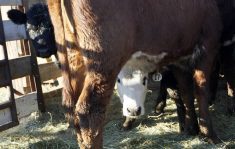A leading American meat official says the greatest challenge facing the North American beef industry is to unite Canadian, Mexican and American food safety regulations without making them burdensome.
“One of the ways we are going to be successful is having our governments harmonize these systems,” Patrick Boyle, chief executive officer of the American Meat Institute, told the Canadian Meat Council meeting in Calgary Feb. 6.
The institute represents U.S. packers and processors.
Boyle said the U.S. Department of Agriculture and the Food and Drug Administration anticipate more pressure to improve surveillance and regulations following the release of an international summary of the American BSE investigation.
Read Also

Saskatchewan dairy farm breeds international champion
A Saskatchewan bred cow made history at the 2025 World Dairy Expo in Madison, Wisconsin, when she was named grand champion in the five-year-old Holstein class.
“We are going to have to be vigilant in assuring they do not go beyond where we need to be.”
He said the United States faces three challenges:
- Consumer confidence must remain strong to deal with surplus beef available since American exports were halted Dec. 23 after BSE was discovered in a cow in Washington state.
Surveys have found heightened BSE awareness among consumers after the discovery, and 10 percent said they were concerned about beef safety.
“The confidence level is about 89 percent in the safety and the integrity of the beef supply,” Boyle said.
- Surveillance must be improved.
BSE tests are increasing to 40,000 per year, especially among sick and fallen stock. These animals must be condemned and there is concern testers won’t find them all.
The U.S. government is talking about incentives to encourage producers to submit these animals for BSE testing.
“The department of agriculture is going to have to find a way, in co-operation with state and local veterinarians, to go out to the farm to collect samples on those non-ambulatory animals.”
- Careful removal of specified risk material and tightening of the ban on feeding remains of ruminant animals to other mult-stomached animals must continue, even though the FDA has said there is 99 percent compliance among feed companies.
“According to the FDA, that is the regulation that has the highest level of compliance of any regulation they have promulgated, administered and enforced,” said Boyle.
Feed companies who violate the ban face $2 million fines and possible prison sentences.
Before BSE was discovered in December, the U.S. sold $3.5 billion US worth of beef to about 120 countries. Half have since closed their borders. Aside from Canada, the remainder are small markets taking lower value products. All major markets are closed.
Boyle said the Japanese beef ban is unreasonable. He said Japan made unattainable demands to test all animals destined for the meat market.
He blamed the Japanese attitude on past mistakes made within their own food regulatory system. BSE, bacterial contamination and labelling scandals eroded public confidence in the food supply and government.
“In an overreaction to the drop in consumer confidence and consumption, they had to impose extreme regulatory obligations to that industry and presented some fairly high hurdles to countries like ours to regain access to that significant overseas market,” he said.















